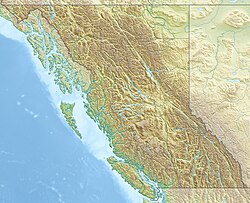| Chutine River | |
|---|---|
| Location | |
| Country | Canada |
| Province | British Columbia |
| District | Cassiar Land District |
| Physical characteristics | |
| Source | Cheja Range |
| • location | Boundary Ranges |
| • coordinates | 57°58′42″N 132°28′57″W / 57.97833°N 132.48250°W[3] |
| • elevation | 1,405 m (4,610 ft)[2] |
| Mouth | Stikine River |
• coordinates | 57°39′9″N 131°37′58″W / 57.65250°N 131.63278°W[1][2] |
• elevation | 117 m (384 ft)[4] |
| Length | 95 km (59 mi)[5] |
| Basin size | 2,629 km2 (1,015 sq mi),[6] |
| Discharge | |
| • average | 140 m3/s (4,900 cu ft/s)[6] |
| Basin features | |
| Tributaries | |
| • left | Piggly Creek, Ugly Creek, Wimpson Creek, Barrington River, Jimjack Creek, Wriggle Creek |
| • right | Dirst Creek, Triumph Creek, Pendant Creek, Conover Creek |
| Topo map | NTS104G12 Chutine River |
The Chutine River (formerly Clearwater River), is a major right bank tributary of the Stikine River in northwestern part of the province of British Columbia, Canada.[1][7] It is located just east of boundary between Southeast Alaska and British Columbia. From its source in the Boundary Ranges of the Coast Mountains the Chutine River flows south and east for about 95 km (59 mi)[5] to empty into the Stikine River at the former settlement of Chutine, near the settlement of Jacksons.
The Chutine River's drainage basin covers 2,629 km2 (1,015 sq mi).[6] The river's mean annual discharge is estimated at 140 m3/s (4,900 cu ft/s), with most of the flow occurring between May and October.[6] The Chutine watershed's land cover is classified as 30.2% barren, 27.4% snow/glacier, 22.6% conifer forest, 9.9% herbaceous, 8.9% shrubland, and small amounts of other cover.[6] The mouth of the Chutine River is located about 40 km (25 mi) southwest of the settlement of Telegraph Creek, 180 km (110 mi) southeast of Juneau, Alaska, about 380 km (240 mi) north of Prince Rupert, British Columbia, and about 695 km (432 mi) northwest of Prince George, British Columbia.
The name "Chutine" comes from an indigenous word meaning "half-people", as in half-Tahltan, half-Tlingit.[1][8]
The Chutine River's drainage basin lies within the asserted traditional territory of the Tahltan First Nations people.[9]
- ^ a b c "Chutine River". BC Geographical Names.
- ^ a b Cite error: The named reference
toporamawas invoked but never defined (see the help page). - ^ Derived from BC Geographic Names, topographic maps, and Toporama
- ^ Elevation derived from ASTER Global Digital Elevation Model, using Toporama, BC Geographic Names coordinates, and topographic maps.
- ^ a b Length measured using BC Geographic Names coordinates, topographic maps, and Toporama
- ^ a b c d e "Northwest Water Tool". BC Water Tool. GeoBC, Integrated Land Management Bureau, Ministry of Agriculture and Lands, Government of British Columbia. Retrieved 26 March 2025.
- ^ "Chutine River". Geographical Names Data Base. Natural Resources Canada.
- ^ Akrigg, G.P.V.; Akrigg, Helen B. (1997). British Columbia Place Names (3rd ed.). University of British Columbia Press. p. 47. ISBN 9780774806374. OCLC 180704220. Retrieved 26 March 2025.
- ^ "Our Territory". Tahltan Central Government, Tahltan Nation. Retrieved 17 March 2025.

